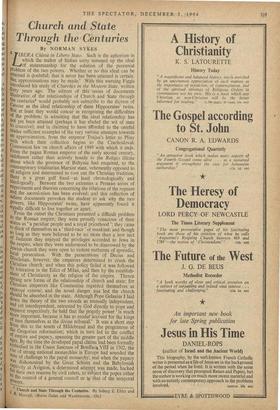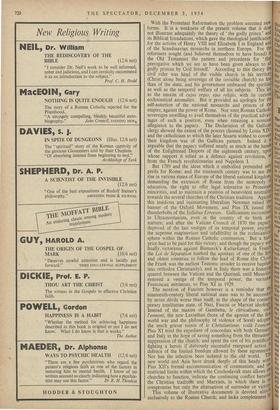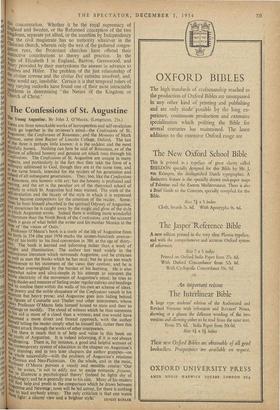Church and State Through the Centuries
By NORMAN SYKES LIB ‘ ERA Chiesa in Libero Stato. Such is the aphorism in which the maker of Italian unity summed up the ideal of statesmanship for the solution of the perennial Problem of the two powers. Whether or no this ideal can be attained is doubtful; that it never has been attained is certain. tut approximations may be made.' With this warning Figgis introduced his study of Churches in the Modern State, written forty years ago. The editors of this 'series of documents illustrative of the relationships of Church and State through the centuries* would probably not subscribe to the dictum of Cavour as the ideal relationship of these Hippocrates' twins. but at least they would concur in recognising the difficulties Of the problem; in admitting that the ideal relationship has not yet been attained (perhaps it has eluded the wit of man to conceive); and in claiming to have afforded to the careful reader sufficient examples of the very various attempts towards an approximation, from the emperor Trajan's letter to Pliny With which their collection begins to the Czechoslovak C,ommunist law on church affairs of 1949 with which it ends. From the pagan Roman emperor of the early second century. Indifferent rather than actively hostile to the Religio illicitu about which the governor of Bithynia had enquired, to the Contemporary totalitarian Marxist state, vehemently opposed to all religion and determined to root out the Christian tradition,' there is a great gulf fixed—at least chronologically and ideologically. Between the two extremes a Protean series of experiments and theories concerning the relations of the regnum and the sacerdotium has been evolved; and this collection of salient documents provokes the student to ask why the two Powers, like Hippocrates' twins, have apparently found it equally difficult to live together or apart. From the outset the Christians presented a difficult problem to the Roman empire; they were proudly conscious of their status as ' a peculiar people and a royal priesthood '; they came to think of themselves as a' third-race' of mankind; and though so long as they were believed to be no more than a new sect Of Judaism they enjoyed the privileges accorded to Jews in the empire, when-they were understood to he disavowed by the Jewish church they were open to violent outbursts of sporadic, ,0eal persecution. With the persecutions of Decius and Lhocletian, however, the emperors determined to crush the Christian church; and when this policy failed it was followed by toleration in the Edict of Milan, and then by the establish- ment of Christianity as the religion of the empire. Thence sprang new forms of the relationship of church and state; for Christian emperors like Constantine regarded themselves as ePiscopi externi; and the novel danger was lest the church should be absorbed in the state. Although Pope Gelasius I laid "own the theory of the two swords as mutually independent, and yet interdependent, entrusted by God directly to pope and emperor respectively, he held that the priestly power ' is much more important, because it has to render account for the kings (2,1 men themselves at the divine tribunal.' It was a short step from this to the tenets of Hildebrand and the programme of the Gregorian reformation; which in turn led to the conflict of empire and papacy, spanning the greater part of the middle ges. By the time the developed papal claims had been formally enlbodied in the Unam Sanctum of Bonifacti.VIII in 1302, the rise of strong national monarchies in Europe had sounded the note of challenge to the papal monarchy; and when the papacy was dishonoured by the Great Schism and the Babylonish aptivity at Avignon, a determined attempt was made, backed Or their own reasons by civil rulers, to subject the popes either to the control of a general council or to that of the temporal P°wers. With the Protestant Reformation the problem assumed new forms. It is a weakness of the present volume that it does not illustrate adequately the theory of the godly prince' and its Biblical foundations, which gave the theological justification for the actions of Henry VIII and Elizabeth I in England and of the Scandinavian monarchs in northern Europe. For the reformers sought (and believed themselves to have found) in the Old Testament the pattern and precedents for that prerogative which we see to have been given always to all godly princes by God himself.' According to this theory the civil ruler was head of the visible church in his territory' (Christ alone being sovereign of the invisible church) no less than of the state, and his government embraced the spiritual as well as the temporal welfare of all his subjects. This led to the maxim of cujus regio, ejus religio, with its curious ecclesiastical anomalies. But it provided an apologia for tlo self-assertion of the national monarchs and princes of tli° empire, against the power of Rome. Nor were Roman Catholic sovereigns unwilling to avail themselves of the practical advarr tages of such a position, even when retaining a nominal allegiance to the papacy. The Declaration of the Gallican clergy showed the extent of the powers claimed by Louis XIS; and the catholicism to which the later Stuarts wished to convert 'their kingdom, was of the Gallican pattern. Indeed it 11 arguable that the papacy suffered nearly as much at the hands of the Enlightened Despots of the eighteenth century, upon whose support it relied as, a defence against revolution, as from the French revolutionaries and Napoleon I. But 1789 and the ideas which it embodied portended nevi perils for Rome; and the nineteenth century was to see Os rise in various states of Europe of the liberal national kingdonl; demanding the extrusion of Rome from the monopoly 0' education, the right to offer legal toleration to Protestant minorities, and to maintain a position of benevolent neutralitY towards the several churches of the Christian tradition. Against this insidious and insinuating liberalism Newman raised the, banner -of the Oxford Movement, and Pius IX issued the, thunderbolts of the Syllabus Errorum. Gallicanism succumbed to Ultramontanism, even in the country of its birth all' nurture; and after the Vatican Council of 1870 the papacy', deprived of the last vestiges of its temporal power, enjoyed, the supreme magisterium and infallibility in the ecclesiastical sphere within the Roman Catholic communion. But a hard price had to be paid for this victory; and though the papacy was finally, victorious against Bismarck's Kulturkampf, in Francs the Loi de Separation marked the apoStasy of one of the first and oldest countries to follow the lead of Rome (for Clovis the Frank was the earliest Teutonic invader to receive baptisin into orthodox Christianity), and in Italy there was a festeripg quarrel between the Vatican and the Quirinal, until Mussolini restored a vestige of the temporal power, the veritable Franciscan minimum, to Pius XI in 1929. The mention of Fascism however is a reminder that the nineteenth-century liberal national state was to be succeeded by seven devils worse than itself, in the shape of the content' porary totalitarian state, of Nazi, Fascist or Marxist ideolOt Instead of the maxim of Gambetta, le clericalisme, voila rennemi, the new Leviathan (born of the agonies of the firs; world war and the philosophy bf violence of Sorel) adopted the much graver tocsin of le Christianisme, voila l'ennefill' Pius XI tried the expedient 'of concordats with both Germal and Italy in the hope of saving something from the threatened suppression of the church; and spent the rest of his pontificate fighting a heroic if dubiously successful rearguard action 11) defence of the limited freedom allowed by these agreemene Tit Nor has the infection been isolated to -the. old world. new world and Asia have drunk deeply of this heady wine; Pius XII's formal excommunication of communists, and tli restricted limits within which the Czechoslavak state allows churches to function, indicate the continuing conflict betwev, the Christian traditidn and Marxism, in which there is 0; compromise but only the alternatives of surrender or victor,' This volume of illustrative documents is devoted ally": exclusively to the Roman Church; and lacks completeness I's this concentration. Whether it be the royal supremacy of England and Sweden, or the Reformed conception of the two kingdoms, separate yet allied, or the assertion by Independency that the civil magistrate has no authority whatever in the Christian church, wherein only the writ of the gathered congre- gation runs, the Protestant churches have offered their distinctive contributions to theory and practice. In the reign of Elizabeth I in England, Barrow, Greenwood, and ,.renry provided by their martyrdoms the answer in advance to nobbes and Hitler The problem of the just relationship of • the civitas terrena and the civitas Dei remains unsolved, and, s°111e would say, insoluble. Certain it is that temporal rulers of Very varying outlooks have found one of their most intractable Problems in determining the Nature of the Kingdom or Church of Christ.'












































 Previous page
Previous page